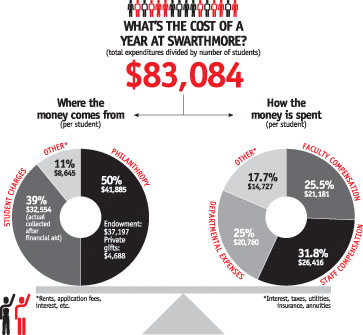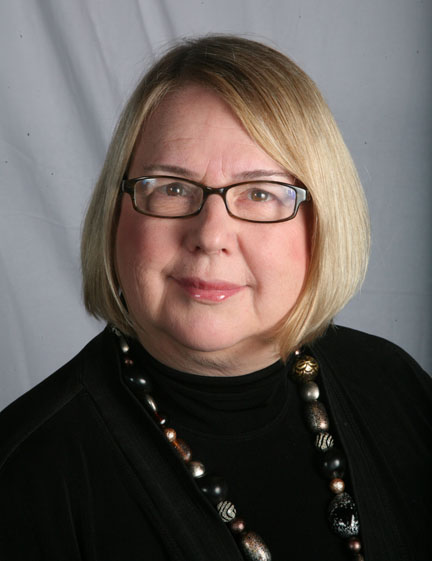[Still] Need Blind in Tough Times

John Boucard ’10
Sara Lipshutz ’11, a busy junior biology major, would not be at Swarthmore without a scholarship. Nor would John Boucard ’10, who plans to go to medical school after graduation. They are just two of the 760 students who are receiving need-based aid at the College this year—about half the student body.
Lipshutz, from New City, N.Y., has been funded since her freshman year with money from the College’s endowment. As a sophomore with a strong interest in the performing arts, she received a Margaret Hall Johnson Scholarship, which continues. This semester, she’s studying at the University of Cape Town, South Africa, in a Swarthmore-sponsored program called Globalization and the Environment. And every dollar of her financial aid went with her.
As a seventh-grader in Newark, N.J., Boucard was identified as gifted and placed in the New Jersey Seeds Program, which helps students gain acceptance into private high schools around the country. After graduating from the Church Farm School in Exton, Pa., he applied to Swarthmore and was awarded a McCabe Scholarship. He wants to become a pediatric surgeon.
Sara and John are real examples of financial aid in action at Swarthmore (learn more by reading the Related Articles links below), but theirs are just two of hundreds of individual stories that could be told year in and year out at the College—and by thousands of alumni whose Swarthmore educations were made possible by scholarships.
But financial aid (in this article, we use the terms interchangeably) doesn’t just help individuals like Sara and John. The fact that the College can meet the financial need of all those who couldn’t attend without such support enriches the entire experience of Swarthmore and makes possible a wide range of economic, social, racial, and geographic diversity.
“Ours is an academically and culturally rich student body,” says President Rebecca Chopp, “and that is largely because we can admit the best students without regard to their families’ ability to pay. We want a student body that brings together all kinds of interests, talents, and backgrounds. Need-blind admissions helps create the kind of varied and dynamic student body we want, allowing us to offer an undergraduate academic, co-curricular, and social experience that shapes leaders who will have a positive impact on our society—both while they’re on campus and after graduation.”
Chopp sees need-blind admissions and meeting students’ financial needs as “core values” of the entire College community—one that reflects the College’s commitment, born of its Quaker traditions, to the common good.

Sara Lipshutz ’11
But when tough economic times call for cost-cutting measures, even the things that matter most don’t escape careful scrutiny. Swarthmore’s scholarships were no exception last year as the Board of Managers considered ways to adjust the College’s budget to new financial realities. And, although protecting need-blind admissions emerged as a guiding principle, challenges to the financial aid program, exacerbated by the economic downturn and the anticipated slow recovery, remain to be addressed in the months and years ahead.
The value that Swarthmore puts on its financial aid program is unusual among colleges, Chopp believes. “The commitment of the whole community to need-blind admissions is unique in my experience,” she says. “Although faculty members typically support need-blind admissions, staff and alumni at Swarthmore also have a sophisticated understanding of why it’s important, and they are enthusiastically committed to it.”
NEED-BLIND, FULL NEED MET
Swarthmore’s need-blind admissions policy is a key reason why scholarships matter so much. “Need-blind admissions” means that U.S. citizens or permanent U.S. residents who apply to the College are admitted without regard for their families’ ability to pay their students’ educational expenses—$51,870 in the current academic year—for tuition, room and board, the student activity fee, books, and personal expenses.
With one exception—McCabe Scholarships awarded to students from Southeast Pennsylvania and the Delmarva Peninsula—the College does not offer merit scholarships to attract high-achieving high school students. Several national McCabe scholarships are granted, based on the same criteria but with aid amounts awarded according to a student’s demonstrated financial need.
And, as an NCAA Division III school, Swarthmore cannot award athletic scholarships.
Once students are admitted, the College is further committed to meeting their full financial needs. On average in the past two decades, 50 percent of students have received need-based aid from Swarthmore. This year, the awards range from $1,000 to $53,000 and average $31,320. The top of the range goes as high as $53,000 because the College allows for two trips home. That transportation allowance varies greatly—quite high for aided students from Hawaii, for example, and much less for students from New York City.
In 2007, to reduce the post-college debt burden on young alumni, the College adopted a “loan-free award” policy that means the College no longer expects students to take out loans as part of their financial aid awards. (Students and their families may still elect to borrow to meet their families’ share of college expenses.)
Finally, students themselves contribute to the cost of their education with earnings from summer jobs and campus work for seven to eight hours per week.
“Need-blind, full need met” admissions and financial aid policies are an endangered species in higher education. Around the country, fewer than 50 colleges and universities—typically, highly selective schools with large endowments—are able to maintain need-blind admissions. At Swarthmore, as at other institutions, the practice is costly.

Swarthmore’s actual cost per student per year far exceeds total student charges. Aided or not, all Swarthmore students receive “hidden scholarships” that represent the difference between the actual cost of their education and the amount for student charges including tuition, room, board, and the student activities fee. The chart above shows how a Swarthmore education was financed in 2008–2009, underscoring the important role philanthropy plays in paying for college costs. (Click image to enlarge view.)
This academic year, the College will spend $23.9 million on scholarships. And this figure does not reflect the so-called “hidden scholarship” given to every Swarthmore student. (See “What’s the Cost of a Year at Swarthmore?” chart at left)
HIGH STICKER PRICE?
Generous financial aid makes Swarthmore affordable for many, but Jim Bock ’90, dean of admissions and financial aid, concedes that the College’s high sticker price can be a deterrent to prospective students.
To recruit a heterogeneous student population, admissions officers pursue a vigorous outreach program that extends beyond typical “feeders” to rural, inner city, and international secondary schools. And wherever they go, the Admissions Office staff is aggressive in getting the word out about financial aid.
“We mail all prospective students our financial aid materials, whether they ask for them or not,” Bock says. “We’re in touch with community-based organizations that reach out to deserving and underserved students. We talk about aid during high school visits, college fairs, and our group sessions for prospective students who visit our campus. We also participate in surveys such as Kiplinger’s and Princeton Review/USA Today, where we often compare favorably for value and cost.”
Last year, Swarthmore students shared their opinions in a survey conducted by the Princeton Review with USA Today, which in turn ranked Swarthmore as having the “highest in level of satisfaction with financial award packages” and named it the “Best Value Private College” for 2010—the second consecutive year the College has earned that distinction.
“We want prospective students to know that cost need not stand in the way of their decision to come here,” adds Laura Talbot, director of financial aid. Talbot points out, however, that money by itself does not necessarily attract students to Swarthmore. “Although students often decide to enroll elsewhere,” she says. “it’s very rare for a student to choose another school simply because of a better aid offer.”
EQUAL ACCESS AND DIVERSITY
Does a need-blind admissions policy really contribute to the goals of equal access and diversity? The evidence suggests that it does. Today, 34 percent of aided students are white, 19 percent are Asian Americans, 16 percent are African Americans, and 15 percent are Latino/Hispanic Americans. Bock, who was himself a scholarship student, is quick to point out that the correlation between need-blind admissions and minority enrollment is not necessarily direct.
“Although we have a high percentage of students of color on campus, they don’t all need our financial aid,” Bock says.
Another seven percent of aided students are foreign nationals. In their case, Swarthmore is not need blind in the admissions decision but does meet their full need once they are admitted. Although the Board of Managers has expressed its support for need-blind admissions for foreign nationals, the necessary funding is not yet available. “Right now, 10 percent of scholarship commitments go to foreign nationals,” says Bock, “but we have far more qualified international applicants than we can fund.”
Like their racial and ethnic backgrounds, the economic status of aided students is also diverse. Their average family income is $107,347, but the range is wide. At one end, 16 percent of aided students’ family incomes are below $40,000; at the other, 24 percent of incomes are more than $150,000. Although $150,000 may sound high, family income is by no means the sole criterion by which awards are made. (See “Who Gets What?”
Although they are commonly measured, racial, geographic, and socioeconomic diversity are not the only positive results of Swarthmore’s ability to provide generous scholarships. “Every student admitted to Swarthmore brings special qualities to the student body,” says Bock. “From the soccer player who is also a theater major to the engineering student who will return to her developing nation to teach, our educational mission is enhanced by every person we admit. Our goal is to have a well-rounded student body with all possible perspectives, talents, and ideas.”
NEED BLIND INTACT—FOR NOW
Alumni consistently put financial aid at the top of the list when asked to rank their priorities for the College. During the last decade, individuals, “matchbox” couples, families, parents, and reunion classes have established nearly 170 new endowed scholarships, each of which covers a portion of the cost of attendance.
Nevertheless, Swarthmore has had to take a long, hard look at its budget, including financial aid expenses, to bring spending in line with considerably diminished endowment income.
As the financial crisis took hold and the College’s endowment declined, an Ad Hoc Financial Planning Group was formed in spring 2009, composed of members of the Board of Managers, administration, faculty, and staff. Anticipating a projected decline in the endowment of as much as 30 percent, the group was charged with developing a contingency plan for reducing endowment support of the budget by $15 million.
The group examined every aspect of life and learning at Swarthmore. Nothing was sacrosanct. “We looked at everything. Everything,” says Vice President for Finance and Treasurer Suzanne Welsh. The group was charged with presenting a plan at the December 2009 Board meeting.
By the summer of 2009, the financial markets had reversed direction and the economy began to show signs of recovery. On June 30, the endowment was down 16.8 percent, far less than earlier projections but a significant drop nonetheless. In December, the Ad Hoc Group recommended an $8 million plan, approved by the Board.
The plan adopted includes modest adjustments to financial aid—among them an increase in the amount that students are expected to contribute from summer jobs—but Swarthmore’s need-blind, full need met policies survived intact.
THE CHALLENGES AHEAD
Even so, challenges to the College’s financial aid program remain to be addressed in the months and years ahead.
Increasingly, students and families look to Swarthmore for help. The College’s scholarship commitments are up 14 percent this year over last year, and up 30 percent during the last two years. (Some of these increases were due to increased enrollment and the implementation of the loan-free awards, but the average need-based scholarship has increased by 7 percent over 2008–2009.)
At the same time, the average contribution expected from parents has dropped. “Our families are fully participating in the recession,” Talbot says. “They’re losing jobs, they’re losing overtime, they’re losing bonuses.”
Yet, financial aid expenses are growing at a rate that is “unsustainable for the future,” says Welsh. By way of illustration, in 1993, scholarships were needed to cover 24 percent of billed student charges (tuition, room, board, activities fee). Today, scholarships are needed to cover 33 percent of student charges. By itself, the College’s commitment to loan-free awards has cost an additional $1.7 million annually.
According to Welsh, Swarthmore has relied on steadily rising endowment income and philanthropy to help meet the demand for scholarships, but within the foreseeable future, the growth of income from these sources will be outpaced by the growth of need.
Next fall, the College will begin a process of strategic direction setting that will consider the future of financial aid and other difficult long-term financial pressures. “As aid increases and the cost of employee health care and other expenses continue to grow,” Chopp says, “we need to look at the financial model that supports Swarthmore and decide how we can maintain our excellence and our core values as the College’s mission evolves.”
In this respect, Swarthmore is by no means unique. “Every school I know is facing the same pressures,” Chopp says.
What will it take to ensure that Swarthmore can continue its policies of need-blind admissions and meeting full need over the long term?
Chopp and Welsh agree that continuing philanthropic support will be critical. This support comes in two forms: gifts to the Annual Fund, which help pay current operating expenses including financial aid; and gifts of endowed scholarships. As financial aid expenses continue to grow, Welsh says, increasing pressure will be put on academic programs, faculty support, libraries, building maintenance, and other aspects of College life—all of which compete with financial aid for College resources.
“Endowed scholarships are funded in perpetuity and provide ongoing, direct support for financial aid,” she says. “Without additional support from endowed gifts, our generous aid awards will have to be reduced—and even need-blind admissions itself may be threatened.”
“Only 57 percent of the scholarships we awarded last year were endowed—and that number will decrease in 2010 because aid is up and the distribution from the endowment has been reduced,” she continues. “This shows the College’s absolute dependence on philanthropy to support future generations of students.”
Chopp adds that “the best way to protect our financial aid program is to make sure we have permanently endowed funds dedicated to direct scholarship support. Fifty-seven percent is a good foundation on which to build, but we will need help from alumni, parents, and friends to preserve this core value.”

Susan Clarey
Susan Clarey is director of advancement communications at Swarthmore College. A journalism major at Syracuse University, she has worked as a newspaper reporter and, later, as executive editor or publisher for Prentice-Hall, Rodale Press, Macmillan, and McGraw-Hill. A Swarthmore resident, Clarey joined the College's Development Office in 2002 and the Communications Office in 2010.

Nigel Holmes self-portrait
Designer Nigel Holmes (cover story) studied in England, freelancing there before moving to the United States in 1978 to be graphics director at Time. Now he runs Explanation Graphics, with clients such as Apple, United Healthcare, and The New York Times. His first children’s book, Pinhole and the Adventure to the Jungle, will be published this summer.
 Email This Page
Email This Page
